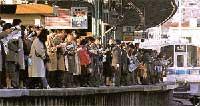The population will not grow in the next century

In today's issue of the journal Nature, an analysis of the population will take place over the next hundred years. This means that in the year 2100 there will be between 5,600 and 12,100 million inhabitants in the world. The probability of this prediction is 80%. Expanding the range increases the probability that the prediction is correct: 4.300-14.4 billion inhabitants with a probability of 95%. The most outstanding result of the research is: From year 2100 the world population will no longer grow and the population curve will begin to descend. The probability of this prediction is 85%.
The authors of the study are Lutz, Sanderson and Scherbov. Predictions have been made using data from around the world. In addition to publicizing the peak of population growth, it has been announced for the year 2050. According to them, the world population in that year ranges from 6.600-11.4 billion (95% probability). The results of the study conducted by the National Research Organization of the United States (NRC) do not coincide with the previous ones. It is estimated that between 7.900-10.9 billion inhabitants (a 95% probability) will be reached in that year. Keep in mind that there are different methods of prediction of probabilities that allow obtaining different results.

Population prediction is not easy. Many variables must be taken into account, and their determination must also be successful. Given all this, the statistics are presented. Until now, the predictions were made by taking a variable and depending on that variable several results were presented.
To better understand the above we will set an example. According to a study, the children aged 6 to 12 in Norway in 2010 will be between 401,000 and 436,000. Both numbers depend on fertility. That is, if in that year every woman has 1.5 children, 401,000 children of that age group, while if you have 2.1 children will be 436.000.
With this data, however, it is not possible to know the probability of one result or another. Therefore, numbering is not enough. To make the result truly reliable, the numbers must be accompanied by their probability. Both the number and probability constitute the ‘prediction interval’ corresponding to the variable we are considering. There are three main methods of probability prediction: time series (based on statistical models adapted from historical data), expert opinion and extrapolation of historical predictions failures.
Buletina
Bidali zure helbide elektronikoa eta jaso asteroko buletina zure sarrera-ontzian











